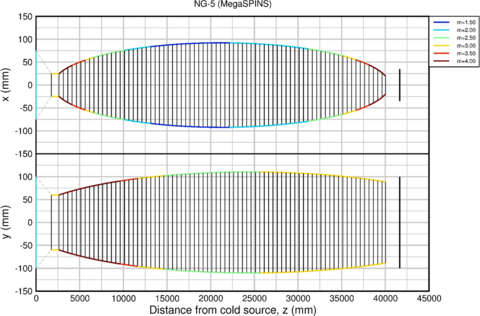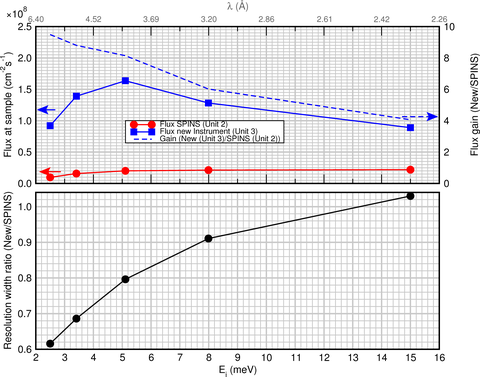The new NG-5
SPINS is one of the older instruments at the NCNR and the beam delivery system including the guide and primary spectrometer should be redesigned to take advantage of the advances in neutron guides and instrument design in the last 25 years. Modern guides for cold-neutron, triple-axis instruments are optimized for a double focusing monochromator. This means that the guide typically provides a virtual source in the horizontal plane while supplying a “parallel” beam in the vertical dimension. Thus we have performed detailed simulations of the primary spectrometer of a new cold-neutron, triple-axis spectrometer on NG-5. We have done this subject to a few constraints. First our budget is insufficient to develop an entirely new instrument. Thus, we will use a new monochromator drum and a double-focusing monochromator mount that we already have. This will allow us to fully optimize the primary spectrometer to maximize the flux at the sample position of an instrument that will be located at the end of NG-5 near the current location of Neutron Depth Profiling (which will be relocated to NG-A′).
The new guide will be straight and elliptical in the horizontal and vertical planes. The diagram below shows the guide profile. Note the dimensions of the x and y axes are very different distorting the guide shape. The vertical lines delineate each segment of the guide, while the color on edge refers to the guide coating.

The expected flux at the sample position is roughly 108 n/cm2-s. This represents a substantial gain from the current situation on SPINS where the calculated flux at the sample position is a little over 107 n/cm2-s. The calculated gain, including the improvement from the new cold source, is shown by the dashed line and approaches 10 at the longest wavelength available on this instrument. Note this uses the calculated flux for both the new spectrometer and SPINS even though the measured flux on SPINS is somewhat less than that calculated. The resolution of the new instrument is better across most of the energy range of interest (see the bottom panel).

The new instrument on NG-5 will be the last item to be completed in this evolution of the NCNR. Thus, we don’t expect this instrument to be available for users before 2027. Also note that we are still seeking funding to provide advanced polarized neutron capabilities and a modern multiplexed analyzer system.

